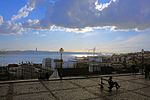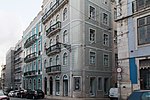Ascensor da Bica

The Bica Funicular (Portuguese: Ascensor da Bica), sometimes known as the Elevador da Bica (Bica Lift), is a funicular railway line in the civil parish of Misericórdia, in the municipality of Lisbon, Portugal. It connects the Rua de São Paulo with Calçada do Combro/Rua do Loreto, operated by Carris. The line conforms to the funicular principle, with two cars permanently attached to opposite ends of a haulage cable, which is looped over a pulley at the upper end of the track. Unusually, traction is provided by electric motors on the two cars, which are themselves powered through an overhead wire. The cable links the two cars together so that they ascend and descend simultaneously, each car acting as a counterweight for the other one.
Excerpt from the Wikipedia article Ascensor da Bica (License: CC BY-SA 3.0, Authors, Images).Ascensor da Bica
Calçada da Bica Pequena, Lisbon Misericórdia (Misericórdia)
Geographical coordinates (GPS) Address Nearby Places Show on map
Geographical coordinates (GPS)
| Latitude | Longitude |
|---|---|
| N 38.708611111111 ° | E -9.1469444444444 ° |
Address
Calçada da Bica Pequena
Calçada da Bica Pequena
1200-399 Lisbon, Misericórdia (Misericórdia)
Portugal
Open on Google Maps









